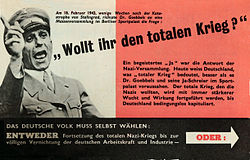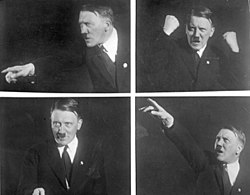Historical analysis

History suggests that the socioeconomic and political context and location influence dramatically the potential for crowd manipulation. Such time periods in America included:
- Prelude to the American Revolution (1763–1775), when Britain imposed heavy taxes and various restrictions upon its thirteen North American colonies; [2]
- Roaring Twenties (1920–1929), when the advent of mass production made it possible for everyday citizens to purchase previously considered luxury items at affordable prices. Businesses that utilized assembly-line manufacturing were challenged to sell large numbers of identical products; [3]
- The Great Depression (1929–1939), when a devastating stock market crash disrupted the American economy, caused widespread unemployment; and
- The Cold War (1945–1989), when Americans faced the threat of nuclear war and participated in the Korean War, the greatly unpopular Vietnam War, the Civil Rights Movement, the Cuban Missile Crisis.
Internationally, time periods conducive to crowd manipulation included the Interwar Period (i.e. following the collapse of the Austria-Hungarian, Russian, Ottoman, and German empires) and Post-World War II (i.e. decolonization and collapse of the British, German, French, and Japanese empires). [4] The prelude to the collapse of the Soviet Union provided ample opportunity for messages of encouragement. The Solidarity Movement began in the 1970s thanks in part to leaders like Lech Walesa and U.S. Information Agency programming. [5] In 1987, U.S. President Ronald Reagan capitalized on the sentiments of the West Berliners as well as the freedom-starved East Berliners to demand that General Secretary of the Communist Party of the Soviet Union Mikhail Gorbachev "tear down" the Berlin Wall. [6] During the 2008 presidential elections, candidate Barack Obama capitalized on the sentiments of many American voters frustrated predominantly by the recent economic downturn and the continuing wars in Iraq and Afghanistan. His simple messages of "Hope", "Change", and "Yes We Can" were adopted quickly and chanted by his supporters during his political rallies. [7]
Historical context and events may also encourage unruly behavior. Such examples include the:
- 1968 Columbia, SC Civil Rights Protest;
- 1992 London Poll Tax Protest; and
- 1992 L.A. Riots (sparked by the acquittal of police officers involved in the assault of Rodney King). [8]
In order to capitalize fully upon historical context, it is essential to conduct a thorough audience analysis to understand the desires, fears, concerns, and biases of the target crowd. This may be done through scientific studies, focus groups, and polls. [3]
It is also imperative to differentiate between a crowd and a mob to gauge the magnitude crowd manipulation should be used to. A United Nations training guide on crowd control states that "a crowd is a lawful gathering of people, who are organized disciplined and have an objective. A mob is a crowd who have gone out of control because of various and powerful influences, such as racial tension or revenge." [9]
Propaganda
The crowd manipulator and the propagandist may work together to achieve greater results than they would individually. According to Edward Bernays, the propagandist must prepare his target group to think about and anticipate a message before it is delivered. Messages themselves must be tested in advance since a message that is ineffective is worse than no message at all. [10] Social scientist Jacques Ellul called this sort of activity "pre-propaganda", and it is essential if the main message is to be effective. Ellul wrote in Propaganda: The Formation of Men's Attitudes:
Direct propaganda, aimed at modifying opinions and attitudes, must be preceded by propaganda that is sociological in character, slow, general, seeking to create a climate, an atmosphere of favorable preliminary attitudes. No direct propaganda can be effective without pre-propaganda, which, without direct or noticeable aggression, is limited to creating ambiguities, reducing prejudices, and spreading images, apparently without purpose. …
In Jacques Ellul's book, Propaganda: The Formation of Men's Attitudes, it states that sociological propaganda can be compared to plowing, direct propaganda to sowing; you cannot do the one without doing the other first. [11] Sociological propaganda is a phenomenon where a society seeks to integrate the maximum number of individuals into itself by unifying its members' behavior according to a pattern, spreading its style of life abroad, and thus imposing itself on other groups. Essentially sociological propaganda aims to increase conformity with the environment that is of a collective nature by developing compliance with or defense of the established order through long term penetration and progressive adaptation by using all social currents. The propaganda element is the way of life with which the individual is permeated and then the individual begins to express it in film, writing, or art without realizing it. This involuntary behavior creates an expansion of society through advertising, the movies, education, and magazines. "The entire group, consciously or not, expresses itself in this fashion; and to indicate, secondly that its influence aims much more at an entire style of life." [12] This type of propaganda is not deliberate but springs up spontaneously or unwittingly within a culture or nation. This propaganda reinforces the individual's way of life and represents this way of life as best. Sociological propaganda creates an indisputable criterion for the individual to make judgments of good and evil according to the order of the individual's way of life. Sociological propaganda does not result in action, however, it can prepare the ground for direct propaganda. From then on, the individual in the clutches of such sociological propaganda believes that those who live this way are on the side of the angels, and those who don't are bad. [13]
Bernays expedited this process by identifying and contracting those who most influence public opinion (key experts, celebrities, existing supporters, interlacing groups, etc.).
After the mind of the crowd is plowed and the seeds of propaganda are sown, a crowd manipulator may prepare to harvest his crop. [10]
Psychological warfare

| Part of a series on |
| War (outline) |
|---|
 |
Psychological warfare (PSYWAR), or the basic aspects of modern psychological operations (PsyOp), has been known by many other names or terms, including Military Information Support Operations (MISO), Psy Ops, political warfare, "Hearts and Minds", and propaganda. [14] [15] The term is used "to denote any action which is practiced mainly by psychological methods with the aim of evoking a planned psychological reaction in other people". [16]
Various techniques are used, and are aimed at influencing a target audience's value system, belief system, emotions, motives, reasoning, or behavior. It is used to induce confessions or reinforce attitudes and behaviors favorable to the originator's objectives, and are sometimes combined with black operations or false flag tactics. It is also used to destroy the morale of enemies through tactics that aim to depress troops' psychological states. [17] [18]
Target audiences can be governments, organizations, groups, and individuals, and is not just limited to soldiers. Civilians of foreign territories can also be targeted by technology and media so as to cause an effect on the government of their country. [19]
Stories are said to be a key factor in a successful operation. [20] Mass communication such as radio allows for direct communication with an enemy populace, and therefore has been used in many efforts. Social media channels and the internet allow for campaigns of disinformation and misinformation performed by agents anywhere in the world. [21]Authority
Prestige is a form of "domination exercised on our mind by an individual, a work, or an idea." The manipulator with great prestige paralyses the critical faculty of his crowd and commands respect and awe. Authority flows from prestige, which can be generated by "acquired prestige" (e.g. job title, uniform, judge's robe) and "personal prestige" (i.e. inner strength). Personal prestige is like that of the "tamer of a wild beast" who could easily devour him. Success is the most important factor affecting personal prestige. Le Bon wrote, "From the minute prestige is called into question, it ceases to be prestige." Thus, it would behoove the manipulator to prevent this discussion and to maintain a distance from the crowd lest his faults undermine his prestige. [22]
Delivery

Churchill
At 22, Winston Churchill documented his conclusions about speaking to crowds. He titled it "The Scaffolding of Rhetoric" and it outlined what he believed to be the essentials of any effective speech. Among these essentials are:
- "Correctness of diction", or proper word choice to convey the exact meaning of the orator;
- "Rhythm", or a speech's sound appeal through "long, rolling and sonorous" sentences;
- "Accumulation of argument", or the orator's "rapid succession of waves of sound and vivid pictures" to bring the crowd to a thundering ascent;
- "Analogy", or the linking of the unknown to the familiar; and
- "Wild extravagance", or the use of expressions, however extreme, which embody the feelings of the orator and his audience. [23]
Hitler

Adolf Hitler believed he could apply the lessons of propaganda he learned in his early World War I experiences and apply those lessons to benefit Germany thereafter. His comments were as follows:
- "[Propaganda] must be addressed always and exclusively to the masses", rather than the "scientifically trained intelligentsia."
- "[Propaganda] must be aimed at the emotions and only to a very limited degree at the so-called intellect."
- "It is a mistake to make propaganda many-sided…The receptivity of the great masses is very limited, their intelligence is small, but their power of forgetting is enormous."
- "[Prepare] the individual soldier for the terrors of war, and thus [help] to preserve him from disappointments. After this, the most terrible weapon that was used against him seemed only to confirm what his propagandists had told him; it likewise reinforced his faith in the truth of his government's assertions, while on the other hand it increased his rage and hatred against the vile enemy."
- "…emphasize the one right which it has set out to argue for. Its task is not to make an objective study of the truth, in so far as it favors the enemy, and then set it before the masses with academic fairness; its task is to serve our own right, always and unflinchingly."
- "[Propagandist technique] must confine itself to a few points and repeat them over and over. Here, as so often in this world, persistence is the first and most important requirement for success." [24] [25]
The Nazi Party in Germany used propaganda to develop a cult of personality around Hitler. Historians such as Ian Kershaw emphasise the psychological impact of Hitler's skill as an orator. [26] Neil Kressel reports, "Overwhelmingly ... Germans speak with mystification of Hitler's 'hypnotic' appeal". [27] Roger Gill states: "His moving speeches captured the minds and hearts of a vast number of the German people: he virtually hypnotized his audiences". [28] Hitler was especially effective when he could absorb the feedback from a live audience, and listeners would also be caught up in the mounting enthusiasm. [29] He looked for signs of fanatic devotion, stating that his ideas would then remain "like words received under an hypnotic influence." [30] [31]